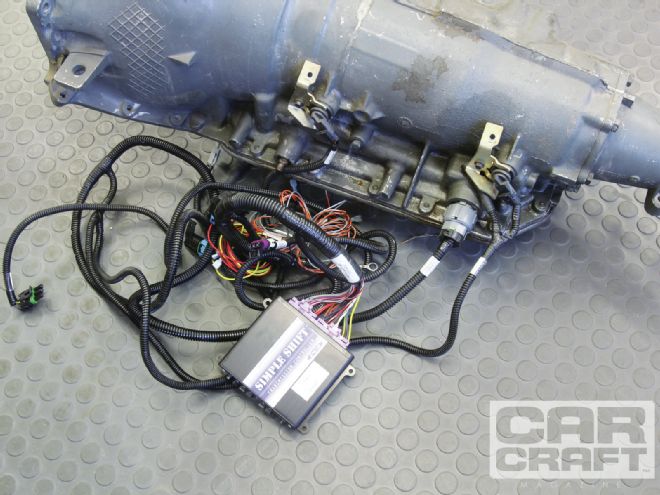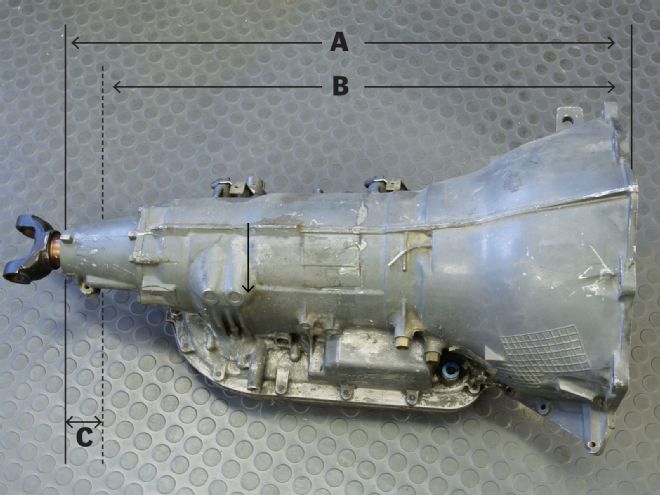
Face it, this is the golden era for horsepower. But that added power puts even more pressure on the rest of the driveline, and no more so than on the transmission. The good news for GM fans is that when it comes to automatic transmissions, there are multiple options. The trans we think has been overlooked is the 4L80E Transmission. This cryptic description is GM’s way of saying this is an automatic transmission with four forward speeds designed for longitudinal (i.e. RWD) use. The "80" references higher torque capacity (compared with a 60, for example), while the "E" defines this as an electronically controlled transmission. We did some research on some of the more important aspects of performance uses for this transmission.
You can think of this trans as basically a TH400 with a 25 percent overdrive tacked on. The 4L80E transmission was mostly used in 3⁄4- and 1-ton trucks and larger SUV applications beginning in 1991. The "E" means that it must use an electronic ECU for control, as it will not function without it. The trans has experienced multiple minor upgrades over the years, with the newer boxes being a bit more attractive, but all the versions can be made to work well in a performance application. The addition of electronic control and overdrive adds roughly 50 pounds and a slight amount of width over a TH400, but for the most part, any floorpan that can accommodate a TH400 can also fit a 4L80E. Also, the 4L80E transmission is typically about 4 inches longer than a TH400 (depending on the length of the extension housing), but the trans mount is located roughly 11⁄2 inches rearward.
Most of the concerns about rL80E transmission revolve around the need for electronic control. Car Craft did an extensive review of five aftermarket controllers in the Mar. ’12 issue, evaluating units from Powertrain Control Systems (PCS), TCI, Chevrolet Performance (GM), CompuShift, and Painless. Be aware that if your car is carburetor-equipped, an aftermarket conversion will also require a throttle-position sensor (TPS) adapter to the carburetor throttle linkage. Holley and most of the companies that sell the controllers also offer a TPS adapter. The price (between $600 and $1,000) and function of these controllers vary, so a review of our story is advised to help you decide which one would be best.
Among the other components you will need to swap in a 4L80E is a rear crossmember. While you can modify an existing crossmember, American Powertrain sells several conversion crossmembers for specific body styles such as first- and second-gen F-bodies, early Chevelles, and ’68-and-newer Novas. These are nice, custom-fabbed aluminum crossmembers that bolt right in. Also, remember that you will probably need either a new driveshaft or have your existing unit shortened. Another important consideration is a torque converter. The stock truck converters are 12-inch lockup monsters that weigh more than 50 pounds and are not performance oriented. B&M, Hughes, Monster, TCI, and others offer both lockup and non-lockup converters with street-performance stall speeds. The price for a good lockup converter ranges from $500 to more than $1,100, so shop around for a deal that fits your budget. Finally, all 4L80E transmissions use an electronic vehicle speed sensor (VSS) output that is not compatible with a mechanical speedometer. There are a couple of options, including a mechanical speedometer extension housing from Shiftworks for $525 or a conversion box called the Cable X from Abbott Enterprises, which converts the electronic VSS (vehicle speed sensor) output into a mechanical-drive cable for around $325. The Cable X also requires an electronic ratio adapter that is an additional $180.
So while the 4L80E is affordable, there is some expense involved with converting it into an earlier chassis. If you’ve been adding up the costs in your head during this story, it wouldn’t be surprising if the cost exceeded $2,000, even if you find a used 4L80E for around $500. But isn’t half the battle knowing how deep the water is before you dive in headfirst? The advantage here is a trans that is even stronger than the original TH400 and offers an excellent 25 percent overdrive.
4L80E Transmission Specs Dimensions (inches) A B C TH400 28-3/4 27-1/4 2-1/2 4L80E 32 30-1/2 4-3/8 These dimensions are for a typical 4L80E but no guarantee that this is true for all transmissions.
Gear Ratio First 2.48 Second 1.48 Third 1.00 Fourth 0.75 Trans Weight w/o converter 4L80E 187 pounds TH400 130 pounds 4L60E 160 pounds TH350 125 pounds
Parts List Description PN Source Price B&M Holeshot 70434 Summit Racing $849.95 TCI Saturday Night Special 242900 Summit Racing 530.95 Monster Street Rage MTB832 Monster 423.21 Hughes lock-up 25A-25L Hughes 569.95 PCS valvebody VBM-2000 PCS 550.00 Abbott Cable-X 30HC-G Abbott Enterprises 339.95 Abbott ERA ERA Abbott Enterprises 180.00 Crossmember ’69 Camaro XFGM-10501 American Powertrain 345.45 Crossmember ’66 Chevelle XFGM-10802 American Powertrain 362.72 4L80E extension housing SW44 (A or B) Shiftworks 525.00
 This is an early-version 4L80E with the trans-cooler lines paired together near the front of the trans. Later versions (called central lube) were upgraded with lubrication improvements, separating the cooler lines with one placed farther toward the rear of the case (arrow). Some trans companies prefer the newer trans, but both can be used in performance applications.
This is an early-version 4L80E with the trans-cooler lines paired together near the front of the trans. Later versions (called central lube) were upgraded with lubrication improvements, separating the cooler lines with one placed farther toward the rear of the case (arrow). Some trans companies prefer the newer trans, but both can be used in performance applications.